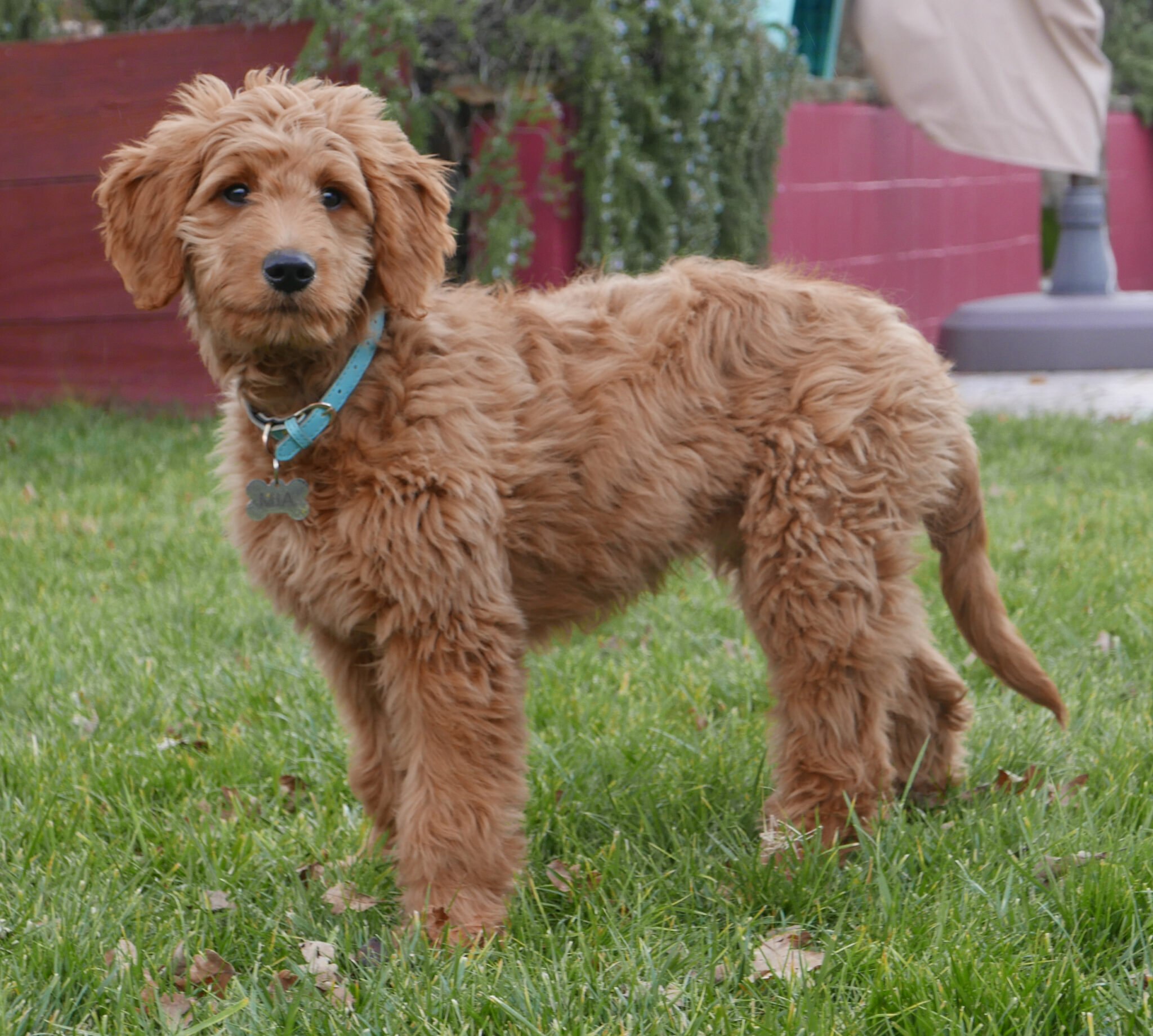If you’ve ever wondered about the growth of Goldendoodles, you’re in the right place! So, when do Goldendoodles stop growing? That’s the question we’re going to answer in this article.
Goldendoodles, those adorable mix-breeds of Golden Retrievers and Poodles, hold a special place in many hearts. They’re known for their lovable personalities and fluffy coats. But like all dogs, Goldendoodles go through different stages of growth.
Understanding when Goldendoodles stop growing is essential for pet owners who want to ensure their furry friends are healthy and happy. So, let’s dive in and explore when Goldendoodles reach their full size.

Table of Contents
- When Do Goldendoodles Stop Growing?
- Tips for Ensuring Healthy Growth
- Key Takeaways: When Do Goldendoodles Stop Growing?
- Frequently Asked Questions
- At what age do Goldendoodles stop growing?
- How can I tell if my Goldendoodle has finished growing?
- Does the size of the Goldendoodle’s parents affect when they stop growing?
- Does diet affect the growth of Goldendoodles?
- Are there any signs of growth-related problems in Goldendoodles?
- When is a Goldendoodle Full Grown? 🐶 We did the math! 🐶 (2022) 🐶
- Summary
When Do Goldendoodles Stop Growing?
Goldendoodles are a popular hybrid breed that combines the intelligence and trainability of the Golden Retriever with the hypoallergenic coat of the Poodle. As a pet owner, it’s important to have all the necessary information about your furry friend’s growth and development. One common question that arises among Goldendoodle owners is, “When do Goldendoodles stop growing?” In this article, we will explore the different growth stages of Goldendoodles and provide you with the answers you need.
Early Growth: The Puppy Stage
During the first few weeks of their lives, Goldendoodle puppies experience rapid growth. Their tiny bodies are constantly developing, and within the first month, they approximately double in size. At this stage, it’s crucial to provide them with proper nutrition and a safe environment to ensure healthy growth.
Between two and four months, Goldendoodles continue to grow rapidly. Their bones and muscles are still developing, and their adult coat may start to come in. This is the time when owners should focus on socialization and basic training to set a good foundation for their puppy’s growth and overall behavior.
By the age of six months, Goldendoodle puppies have reached a significant portion of their adult size. While they may still have some growing to do, it is during this stage that their growth rate begins to slow down. However, it’s important to note that the exact time when a Goldendoodle stops growing can vary depending on factors such as genetics, size, and overall health.
Adolescence: Transitioning to Adulthood
As Goldendoodles enter their adolescent stage, typically around six to twelve months of age, their growth rate further slows down. While their bodies may continue to develop, the changes are more subtle during this time. It is vital for owners to consistently provide them with a balanced diet, regular exercise, and mental stimulation to support their overall health and well-being.
Goldendoodles reach sexual maturity around the age of 9 to 12 months. This is an essential period for spaying or neutering your Goldendoodle if you do not plan to breed them. Consulting with your veterinarian about the best time for this procedure is highly recommended.
By the time they reach their first birthday, most Goldendoodles have reached their maximum height and have filled out their build. However, it is important to keep in mind that they may continue to mature and develop physically until they reach around 18 to 24 months of age. Each Goldendoodle is unique, and the timing of their growth can vary.
Adult Growth: Reaching Their Full Potential
Once Goldendoodles have completed their growth spurts, they enter into their adult stage. By this time, they have reached their full potential in terms of size and structure. The adult size of a Goldendoodle can depend largely on their genetic background, as well as the size of the parent breeds.
The size variations of Goldendoodles can range from standard, medium, to miniature, with standard Goldendoodles typically being the largest and miniatures being the smallest. Standard Goldendoodles can reach a height of 21 to 26 inches and a weight of 45 to 80 pounds, while miniatures can range from 13 to 20 inches in height and weigh between 15 to 35 pounds.
It’s important to note that Goldendoodles, like any other breed, require regular exercise, a balanced diet, and routine veterinary care throughout all stages of their lives. By providing them with proper care, you can ensure they live a happy and healthy life.
Factors Influencing Growth
While the general growth pattern of Goldendoodles follows certain stages, it’s essential to consider various factors that can influence their growth and development. Here are a few factors that can play a role in when a Goldendoodle stops growing:
1. Genetics: Genetic factors play a significant role in determining a Goldendoodle’s adult size and growth rate. The size of the parent breeds can influence whether a Goldendoodle leans more towards the larger or smaller end of the size spectrum.
2. Nutrition: Providing a balanced diet that includes high-quality food specifically formulated for puppies or adult dogs is crucial for proper growth. Consult with your veterinarian to determine the best diet plan for your Goldendoodle at each stage of their life.
3. Health: Good overall health is essential for optimal growth. Regular check-ups with a veterinarian, vaccinations, and preventive care all contribute to a Goldendoodle’s growth and development. Any health issues should be addressed promptly to ensure they do not hinder the growth process.
4. Exercise: Regular exercise is vital for a Goldendoodle’s physical and mental well-being. Controlled exercise, especially during the puppy stage, helps develop strong muscles and bones. However, it’s important to strike a balance and avoid excessive exercise that can put unnecessary strain on growing joints.
Tips for Ensuring Healthy Growth
Now that you have a better understanding of the growth stages of Goldendoodles, here are some tips to ensure healthy growth and development:
1. Feed a balanced diet: Provide a high-quality dog food that meets the nutritional needs of your Goldendoodle at their specific life stage. Consult with your veterinarian for recommendations on the best diet plan.
2. Monitor weight: Keep track of your Goldendoodle’s weight throughout their growth stages. Excessive weight gain or loss can indicate health issues or improper nutrition.
3. Exercise appropriately: Provide regular exercise suited to your Goldendoodle’s age, size, and energy levels. Avoid excessive high-impact activities that can strain growing joints.
4. Socialize and train: Proper socialization and basic training help shape your Goldendoodle’s behavior and ensure they grow into well-adjusted adult dogs. Enroll in puppy classes or consult with a professional trainer to get started.
5. Regular veterinary care: Schedule routine check-ups with a veterinarian to monitor your Goldendoodle’s growth, address any health concerns, and stay up-to-date on vaccinations and preventive care.
By following these tips and providing your Goldendoodle with the love, care, and attention they need, you can ensure they grow into happy, healthy adult dogs. Remember, each Goldendoodle is unique, and their growth and development may have slight variations. Consulting with a veterinarian is always recommended to address any specific concerns you may have about your Goldendoodle’s growth.
Key Takeaways: When Do Goldendoodles Stop Growing?
– The size of the parent breeds (Golden Retriever and Poodle) can influence the growth rate of a Goldendoodle.
– Smaller Goldendoodles tend to reach their full size earlier than larger ones.
– Factors like nutrition and exercise can also affect the growth of a Goldendoodle.
– It’s important to monitor the growth of your Goldendoodle and consult with a veterinarian for guidance.
Frequently Asked Questions
At what age do Goldendoodles stop growing?
Goldendoodles typically stop growing between 10 and 12 months of age. However, the exact age at which they reach their full size can vary depending on several factors, including genetics, diet, and exercise. It’s important to note that while their height and length may reach their maximum during this period, their weight might continue to increase slightly until they are about 18 months old. It’s essential to provide them with a balanced diet and regular exercise to support healthy growth and development.
During their growth stage, Goldendoodles experience significant changes in their body structure and coat. Their bones and joints are still developing, so it’s crucial to avoid excessive exercise or activities that could strain their growing bodies. Regular visits to the veterinarian can help monitor their growth progress and ensure they are on track for healthy development.
How can I tell if my Goldendoodle has finished growing?
While there is no definitive way to determine if a Goldendoodle has finished growing, there are some signs to look for. One indication is if your Goldendoodle has reached their breed’s standard height and weight. However, keep in mind that individual Goldendoodles can vary in size, so comparing them to the breed standard may not always be accurate.
Another sign is if your Goldendoodle’s growth plates have closed. Growth plates are areas of developing cartilage at the ends of long bones that determine bone length and shape. Once these growth plates close, the bones can no longer grow in length. A veterinarian can perform X-rays to assess the status of the growth plates and determine if your Goldendoodle has finished growing.
Does the size of the Goldendoodle’s parents affect when they stop growing?
Yes, the size of the Goldendoodle’s parents can have an impact on when they stop growing. Goldendoodles are a hybrid breed, resulting from the crossbreeding of a Golden Retriever and a Poodle. The size of the parents can influence the size of the offspring, including their growth rate and when they reach their full size.
If a Goldendoodle has larger-sized parents, they may take longer to reach their full size compared to those with smaller-sized parents. However, it’s important to note that other factors, such as genetics and individual variation, can also play a role in determining when a Goldendoodle stops growing.
Does diet affect the growth of Goldendoodles?
Yes, diet can play a significant role in the growth of Goldendoodles. Providing a balanced and nutritious diet is crucial for their overall health and development. A diet rich in high-quality protein, healthy fats, and essential vitamins and minerals can support proper bone and muscle growth.
It’s important to feed your Goldendoodle a diet specifically formulated for their life stage, whether it’s puppy, adult, or senior. Consult with your veterinarian to ensure you are providing the appropriate diet and portion sizes for your Goldendoodle’s specific needs. Avoid overfeeding, as excess weight gain can put unnecessary strain on their growing bones and joints.
While Goldendoodles are generally healthy and robust dogs, there can be some growth-related problems that may occur. One common issue is hip dysplasia, which is a condition where the hip joint doesn’t develop properly and can lead to discomfort and mobility issues. Other potential problems include elbow dysplasia, luxating patella, and certain bone disorders.
It’s important to monitor your Goldendoodle’s growth and watch for signs of limping, difficulty walking or running, reluctance to exercise, or any other unusual behavior. If you notice any concerning symptoms, it’s crucial to consult with a veterinarian who can evaluate your Goldendoodle and provide appropriate treatment or management strategies if necessary.
When is a Goldendoodle Full Grown? 🐶 We did the math! 🐶 (2022) 🐶
Summary
So, to summarize what we’ve learned about Goldendoodles and when they stop growing:
First, Goldendoodles are a mix between Golden Retrievers and Poodles, and they come in different sizes. Small Goldendoodles usually stop growing around 10-12 months, medium-sized ones around 12-14 months, and large ones around 14-16 months.
Secondly, it’s important to remember that each Goldendoodle is unique, and their growth can vary. Some may stop growing a little earlier or later than the average times we mentioned.
In conclusion, if you have a Goldendoodle puppy, it’s good to know when they might reach their full size. Remember to give them lots of love, care, and proper nutrition during their growing years. And don’t forget, even though Goldendoodles may stop growing, they’ll always be young at heart and ready to bring joy to your life!



